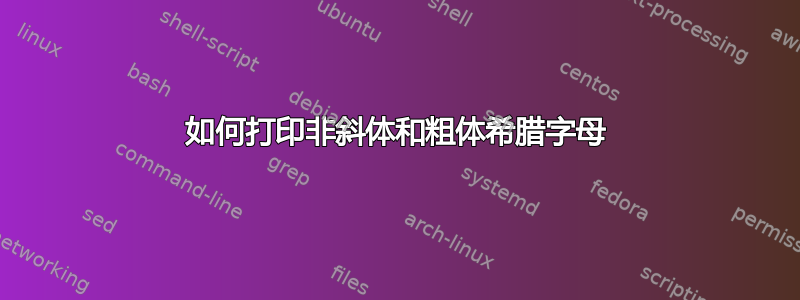
答案1
选择具有理想形状且与您的文本字体兼容的数学字体。在这里我选择了mathptmx,因为它看起来与您的要求相似。然后,如果您使用 pdflatex,您可以使用这种倾斜方法使倾斜的字母直立。在 MWE 中,我显示了正常的(斜体)希腊字母,然后在其下方显示了非倾斜版本。
根据我的回答直立希腊字体适合计算机现代
\documentclass[a4paper]{article}
\usepackage{mathptmx}
\newsavebox{\foobox}
\newcommand{\slantbox}[2][0]{\mbox{%
\sbox{\foobox}{#2}%
\hskip\wd\foobox
\pdfsave
\pdfsetmatrix{1 0 #1 1}%
\llap{\usebox{\foobox}}%
\pdfrestore
}}
\newcommand\unslant[2][-.18]{\slantbox[#1]{$#2$}}
\begin{document}
$\omega\upsilon$\par
$\unslant\omega%
\unslant[-.1]\upsilon$
\end{document}
补充
它通常馊主意混合搭配字体。但 OP 暗示想要这样做。如果有人想走这条路,说使用 Computer Modern italic 作为默认数学字体,但想要访问 mathptmx greeks 以进行反倾斜,那么这将是一种方法。正如您所见,它们都在同一个数学环境中可用……而且它们在一起看起来不太好。就是这样。
\documentclass[a4paper]{article}
%\usepackage{mathptmx}
\newsavebox{\foobox}
\newcommand{\slantbox}[2][0]{\mbox{%
\sbox{\foobox}{#2}%
\hskip\wd\foobox
\pdfsave
\pdfsetmatrix{1 0 #1 1}%
\llap{\usebox{\foobox}}%
\pdfrestore
}}
\newcommand\unslant[2][-.18]{\slantbox[#1]{$#2$}}
\DeclareSymbolFont{greeksymbols}{OML}{ztmcm}{m}{it}
\DeclareMathSymbol{\altomega}{\mathalpha}{greeksymbols}{"21}
\DeclareMathSymbol{\altupsilon}{\mathalpha}{greeksymbols}{"1D}
\begin{document}
$a\omega\upsilon\altomega\altupsilon$\par
$a\unslant\omega%
\unslant\upsilon
\unslant\altomega%
\unslant[-.1]\altupsilon$
\end{document}
答案2
答案3
在 PDFLaTeX 中,加载 OML 编码的直立字体,这是唯一支持拉丁文和希腊文的 8 位编码。然后您可以在\mathnormal、\mathrm和中使用希腊字母\mathbf。
\documentclass{article}
\usepackage{amsmath}
\usepackage[utopia]{mathdesign}
\usepackage[rmdefault=mdput,
OMLmathrm,
OMLmathbf
]{isomath}
\begin{document}
\begin{align*}
\omega &\quad \upsilon \\
\mathrm{\omega} &\quad \mathrm{\upsilon} \\
\mathbf{\omega} &\quad \mathbf{\upsilon}
\end{align*}
\end{document}
您也可以使用\boldsymbol{\mathrm{\omega}}。
合适的 8 位数学字体并不多,但可以使用rmdefault=mdbch和。\usepackage[charter]{mathdesign}rmdefault=mdugm\usepackage[garamond]{mathdesign}
在这里,我使用了界面,但您也可以使用或isomath自己定义数学字母。\DeclareMathAlphabet\DeclareSymbolFontAlphabet
在 LuaLaTeX 或 XeLaTeX 中,您可以使用unicode-math。所有 OpenType 数学字体都支持\symup和\symbfup,并且有包选项可以制作\mathrm和\mathbf这些的别名,以便与上述代码向后兼容。
\documentclass{article}
\usepackage{fourier-otf} % Sets up Erewhon Math in unicode-math
\begin{document}
\begin{align*}
\omega &\quad \upsilon \\
\symup{\omega} &\quad \symup{\upsilon} \\
\symbfup{\omega} &\quad \symbfup{\upsilon}
\end{align*}
\end{document}








